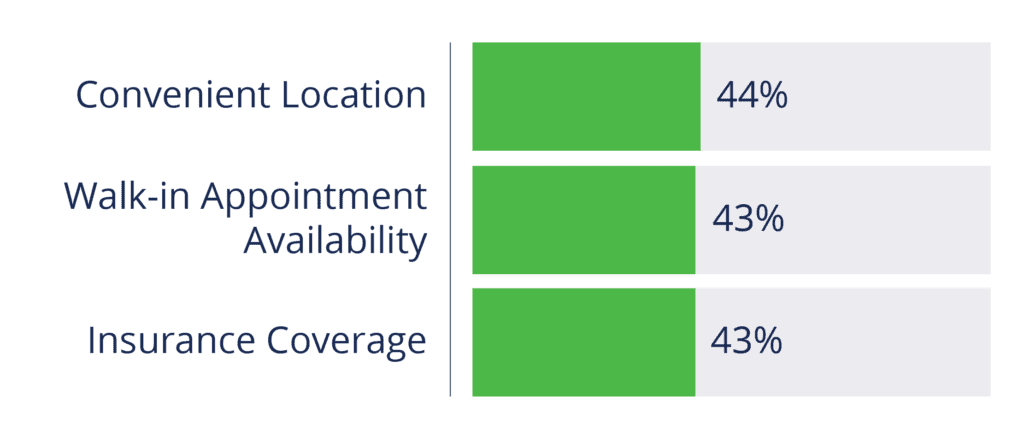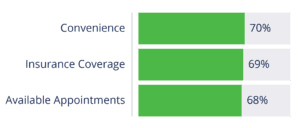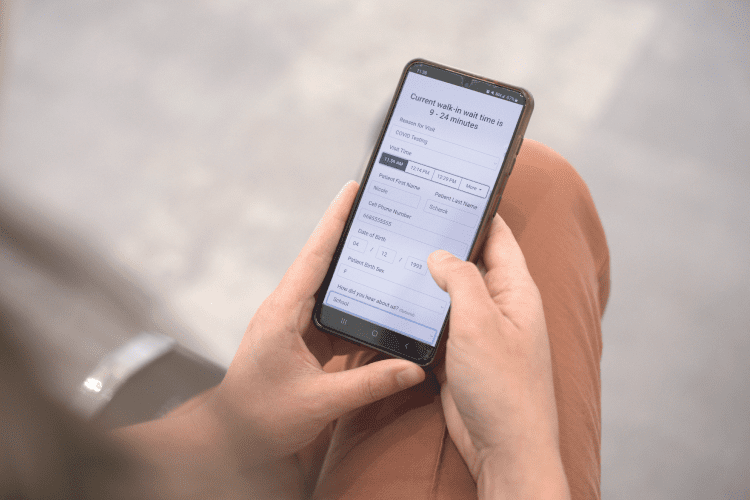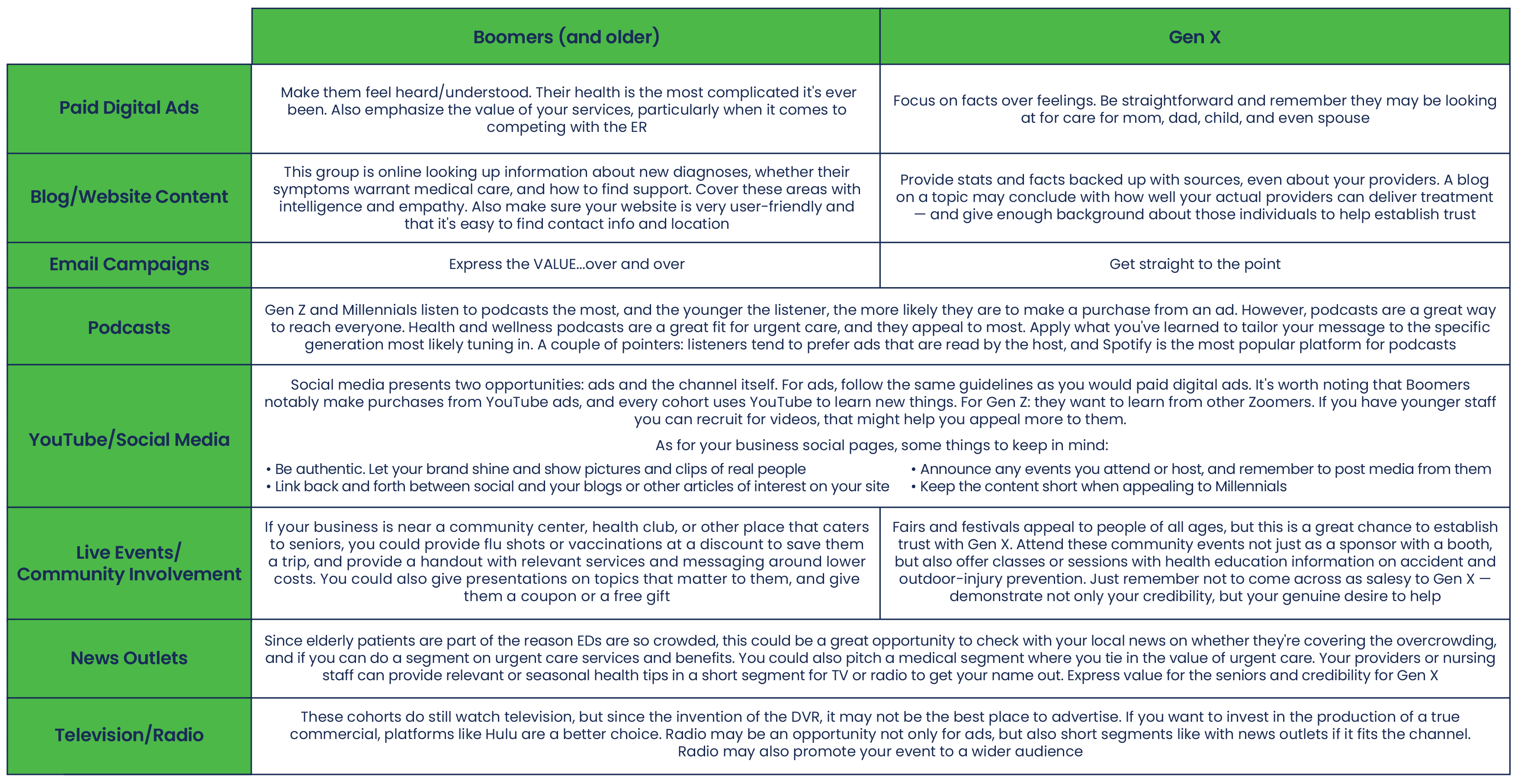
Overcrowding in the emergency department continues to be a problem that strains healthcare resources and diminishes the patient experience. This is extremely relevant to our industry because many of the ED patients could be treated at urgent care — in a fraction of the time.
This news is especially frustrating when visit volumes are low and dependable revenue like a heavy flu season don’t pan out as usual.
While it seems some hospital healthcare professionals are trying to promote urgent care when they can, the onus is on those in urgent care to communicate what a relevant and appealing alternative it is to the ED.
Drawing patients out of the ED will help bolster revenue.
For any of these things to gain traction, you need to communicate to your communities that you offer these services. There are a lot of ways to market today, but what’s best for what audience? What does a smart marketing campaign include? How do answers to these questions influence the type of services you should provide?
This guide walks you through insights and data that can help you best serve your community while increasing business long-term.
If the objective is to reach and persuade more people to visit so that you have higher, steadier revenue long-term, we need to consider two closely related factors:
What services do people want based on their preferences, and how do you market to people of varying habits, expectations, and values?

To understand how these two pieces come together, we look to this JUCM article that summarizes research that WD Partners conducted on how 2,600 consumers between 18 and 80 years of age used and perceived PCPs, retail clinics, and urgent care.
Survey results show clear indications that Gen Z and Millennials are progressively looking to move away from the PCP’s office and toward more accessible, low-cost options. In fact, the younger the consumer, the less likely they were to have a PCP, and the more dissatisfied they were with primary care.
As for the older consumers, even though 90% prefer PCPs, unfamiliarity was the top reason that Boomers (44%) and the Silent Generation (50%) reported not considering urgent care facilities for services. In fact, according to a National Library of Medicine article, an increase in presentations by the elderly is one of the top reasons EDs are struggling. The number of nonurgent and unnecessary visits were also cited among other factors, which really drives home the need to communicate what urgent care can do.
So when it comes to serving these populations, branding and education — along with addressing pain points — can help make urgent care a more preferred avenue for healthcare.
When thinking about expanding services to better meet the needs of today’s patient, the article shared interesting findings around what the respondents would consider as far as urgent care add-on treatments.
“Respondents reported that they would consider urgent care facilities for a variety of services. The most common reasons consumers claimed that they would consider this provider for add-on care were for the treatment of health conditions like flu symptoms (44%) and ear infections (41%). For specialized services, the top add-ons are imaging and testing (34%). The most popular wellness service that they would consider at urgent care were for the treatment of sleep issues (14%), but overall, 59% of respondents reported that they would not consider an urgent care facility for their wellness needs.
The interesting story related to wellness needs started when we looked at sleep issues by age. Looking at Gen Z, 23% would consider urgent care for sleep issues compared to only 8% of Baby Boomers. When it comes to specialty care, 39% of Gen Z would consider urgent care for allergy treatment compared to only 25% of Boomers.”
This is especially relevant to urgent care centers who currently or may in the future offer wellness services. It doesn’t mean you will fail if you try; it means you need to be smart about how you position yourself. That means education, branding, and potentially, offering services incrementally starting with what is most appealing and building on that as you gain visibility and trust.
Ultimately, as stated in the article, “this creates an opportunity for urgent cares to establish a value proposition that reinforces the perception of trust, quality and professional competence in order to show that they are capable of providing significantly more types of care.“
We’ll get into types of care in our chapter on services. Now let’s focus on some marketing fundamentals that help with how you’re perceived.
Your marketing opportunities are vast, but no matter what channels you communicate through, there are core marketing elements you cannot live without if you want any campaign to be successful.
As stated in the JUCM article, “The current market is saturated with independent urgent care centers that aren’t widely trusted by consumers due to their lack of brand recognition.” This makes sense as a lot of people who open urgent care centers have healthcare expertise, not marketing experience.
Identifying your brand and communicating it consistently across all of your touchpoints (from ads to signage to the patient experience) helps you not only differentiate yourselves amongst competition, but also establish familiarity with potential new patients.
We’ll leave deeper details about branding and team culture to this blog, but to get you started, think about the answers to these questions:
Think very carefully about your brand because you want it reflected in everything you do, and everything the patient sees. Inconsistent messaging confuses patients about who you are, and rebranding is a big lift. So be sure you’re happy with your brand before you broadcast it.
When it comes to marketing, people are far less interested in what you do than they are in how it benefits them. Two of the main reasons we know people should choose urgent care over the emergency room, for example, are that it’s faster and less expensive. But generically advertising fast service for less is not as effective as saying “high-quality care that costs less than the emergency room and takes a fraction of the time.”
CVS is utilizing this now. If you Google “urgent care near me,” odds are you’ll see an ad for CVS on page one with a headline reading: “Cheaper than urgent care.”
This tactic not only calls out a major pain point for patients (cost,) but also puts CVS in search results for urgent care.
The point is, you want to identify what major problems you solve for healthcare and put that front and center in your marketing. It may not make sense to put it everywhere (unless it’s in your tagline,) but it should shape your messaging.
This begs the question: what known pain points do patients have? We can glean a few based on what the JUCM article revealed about what patients valued:
“When thinking about their most recent visits to these facilities, respondents said they chose this option because of:

They rated their visits to these facilities similarly, with the following being their most valued features:

This Healthcare Success blog cited a survey by Kelton Global that revealed shared expectations across generations include:
As for ED-specific messaging, it’s worth noting what Yale News reported: “For patients, studies have found that ED crowding is correlated with discomfort, reduced privacy, treatment delays, and higher risk of prolonged disease and death.”
Of course, if you’re making a claim in your marketing, it darn well better be true. If you need help reducing wait times or adopting patient scheduling options, this blog can help.

A lot of your marketing will be for future needs. You’re telling people who you are and what you offer so that when they need care, or are planning a specialized service, they consider you.
But what’s even more important is showing up where people are looking when they need treatment NOW.
The absolute most important way to do this is to have a mighty web presence. This blog helps you understand how to show up in web searches, improve your reviews, and put your best foot forward in the digital space.
Digital considerations aside, you still need clear, visible signage. For immediate needs, you want to be easy to find once a patient has decided to come to you. But this also contributes to your long-term marketing. If people consistently see your sign when they drive past you, in their time of need, they might remember there’s an urgent care by Target and either bypass a Google search or type in “urgent care by Target, Lansing” (for example).
If you don’t have a location with great signage opportunities, you can consider a mobile billboard. If there’s a place to park in the street or parking lot where it’s visible to cars passing, it’s a great workaround.
Before you get into more specific marketing strategies for diversified services, let’s go back to thinking about your consumers. You need to know what they care about before you can be tactical about communicating with them.
What people want is fairly consistent across the generations. This goes back to after-hours care, convenience, and other benefits explained in the pain points section. Pain points may vary depending on your services, though, like for behavioral health, pediatric care, etc. But how they want information is where you’re going to build different, effective marketing strategies. Let’s take a look at some of the identifying perceptions, values, expectations, and characteristics of the different age cohorts.
Older generations may not be as tech-savvy as other generations, but don’t mistake them as tech-incompetent. They’re using social media, apps, and the Internet in general. Yes, traditional media like TV and newspapers appeal more to them than other audiences, but Healthcare Success references Google in saying, “The Internet is their ‘top source for gathering information on topics of interest, outpacing TV and print media by a substantial margin,’” that “Looking for medical/healthcare information is one of the top three reasons (66 percent) that seniors use the Internet,” and “…the Internet is the number one source of information and health topics are significant to (60 percent) Boomers/Seniors.”
The biggest hurdle urgent cares have with these demographics is their loyalty based on familiarity. As JUCM put it, “Baby Boomers and the Silent Generation value longtime PCP loyalty, and for good reason: they have more complicated medical histories and typically need more extensive care.”
So you really need to focus on those services that they cannot get with their PCP and that they shouldn’t be wasting time and money in the ER to resolve. Here are some things to keep in mind when marketing to them:
Gen X is sort of the overlooked generation. And while they’re cool with that, you’d be remiss to ignore them. They are making or influencing medical decisions not only for themselves, but potentially also their parents and their children.
One hurdle with this group is that Gen X is generally mistrusting of establishments and advertising. They are particularly skeptical of healthcare claims. Here are some considerations when marketing to the middle-aged:
All of the sources we reviewed claim that Millennials (also Gen Y) are currently the largest population. Their children range from infants to teenagers. And they grew up with the Internet — they are where we see a sharp shift in preferences related to technology. Which isn’t just about convenience; they don’t trust services that don’t use tech. Here are a few more details about them:

Zoomers are making a significant impact on healthcare. They’re reportedly more stressed than any other generation, and many define their mental health as fair or poor. Yet they are also more likely to seek help. They may be young, but if you can connect with them and gain their trust, you’re creating lifetime patients.
The data shared in the JUCM article hits urgent care where it hurts: “28% of Gen Z respondents said that they didn’t consider an urgent care because of wait times in treatment rooms, and their second most cited reason was because of long waiting room times.”
This is very consistent with their lifetime experience of having instantaneous access to information and plentiful service options where they sign up and things show up at their door.
Your future depends on appealing to this generation. The good news is they’re more likely to Google conditions and use walk-in clinics and urgent cares because of the convenience. However, they’re starting to get their own health insurance, so you don’t have long to catch up if your tech is antiquated.
Here are a few marketing points about Gen Z:



You don’t have to take on a billing audit alone. Experity has performed over 400 no-obligation, free billing analyses to help urgent cares identify what’s working well and where to improve in their RCM. Get yours to not only better defend payer reviews, but also optimize your revenue.
Now that you have an idea of what the people in your communities want, let’s review some service options. We’ve put out a lot of content around expanding service lines and improving acuity, so we’ll keep it brief.
Think about the community/communities you serve and who you’re serving. You may be close to schools, retirement facilities, sporting venues, transportation companies, and tourism hotspots. You could be near trails and parks that draw a lot of active people. All of these things factor into what type of services will be most attractive to patients.
With that in mind, here are some ideas on expanding your offerings and/or what to market to your community.
We also provided a list of higher-acuity treatments you can offer in a previous eBook. It includes:
Obviously, there are many more opportunities, and the list will only get bigger as time goes on. The most important thing is that you’re shaping your business based on what makes sense for the people in your individual community.
Let’s recap a few things we learned about the generations who determine your future success.
If any of this has you thinking you need some upgrades, patient engagement technology and the right EMR/PM can help — even with waiting and treatment room times.
Patient engagement technology is how you can utilize online reservations through the website, virtual waiting rooms, wait time transparency, and more. The technology helps significantly reduce perceived wait time as well as actual wait time (with online pre-registration).

As for treatment room time, if your providers spend more than a minute on most charts, your EMR is not as efficient as it could be. Your tech should reduce manual efforts through automation and speed up processes so that providers aren’t spending time on menial tasks instead of with patients.
Experity’s EMR/PM and Patient Engagement tool check all of these boxes and more. Read about our solutions here or bookmark the page for when you’re ready to shop around.